As the days grow shorter and the temperatures drop, many of us adjust our routines to accommodate the colder weather—whether it’s layering up before a walk or swapping iced coffee for something warm. But what about our pets? Winter can be just as challenging for them as it is for us. With a little creativity and the right tools, you can help your furry friends stay happy, healthy, and cosy all season long.
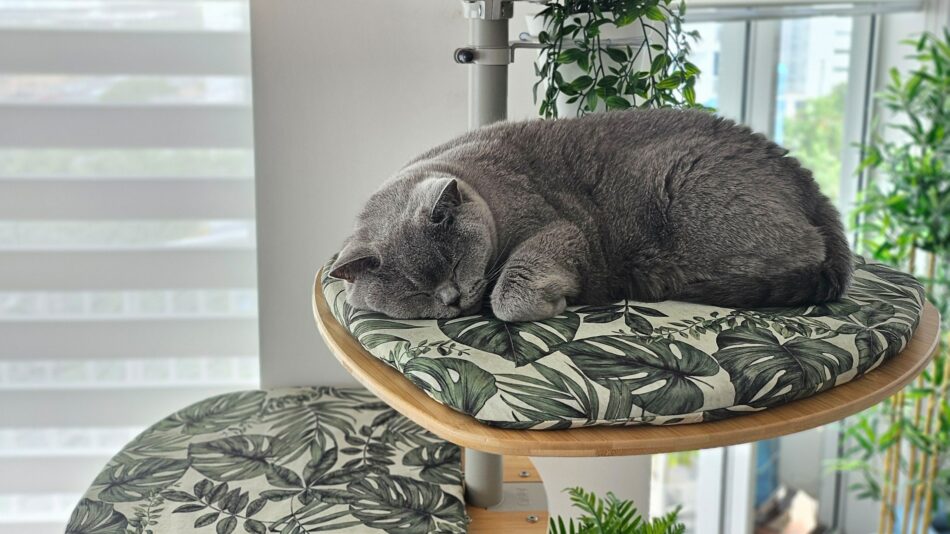
Get moving indoors
Cold weather and icy conditions can make outdoor activities less appealing, but keeping your pets active is essential for their physical and mental well-being. For dogs, bring the fun inside by creating an agility course using household items like chairs and blankets. Hide-and-seek is another great option—hide treats or a favourite toy and let your dog sniff them out. If your dog is high-energy, consider tug-of-war games or fetch in a long hallway or basement. These indoor activities not only keep your pup moving but also help to burn off excess energy when outdoor time is limited.
Cats, too, need to stay active during the colder months. Winter is a great time to introduce new interactive toys, like wand teasers or laser pointers, to keep them engaged. Products like the Freestyle Indoor Cat Tree designed by Omlet can transform your home into a feline playground, offering vertical spaces for climbing and scratching. If your cat enjoys hunting-style play, try puzzle feeders or treat-dispensing toys to stimulate their natural instincts. These small changes can go a long way in keeping your pets happy and healthy through the season.
Winter-proof your walks
Winter walks can still be a highlight of your dog’s day if you’re prepared. Start with proper gear—invest in a warm, waterproof coat to protect your dog from the chill, especially if they have short fur. Paw balm or boots are also great options to shield sensitive paw pads from icy sidewalks and salt. Adjust your usual route to include paths that are clear of snow or ice and aim for daylight walks when temperatures are at their peak. Remember, shorter walks are fine when the weather is harsh, so long as you make up for it with indoor activities.
Cats aren’t typically fans of winter adventures, but some indoor/outdoor cats may still want to explore. Keep an eye on the weather and limit outdoor time to prevent exposure to extreme cold. Consider setting up an outdoor Catio for brief outdoor breaks where your cat can enjoy the sounds and feels of nature. For cats who love window-watching, a warm perch near a sunny spot can offer hours of entertainment. Whether they’re indoor or outdoor, ensuring your pets stay safe and comfortable is key during the colder months.
Create a cosy retreat
Winter is all about creating comfort, and your pets deserve a space where they can retreat from the cold. For dogs, a cosy bed placed away from drafts is a must. Omlet’s Bolster Dog Bed offers ultimate comfort, with plush cushioning to support your pup’s rest. You can also add a soft blanket or heated pad for extra warmth. If your dog enjoys being close to the action, consider setting up their bed in the living room so they can relax while staying near you.
Cats are masters of finding the cosiest spots in the house, but you can make their winter even more enjoyable by enhancing their favourite nooks. Heated beds or self-warming mats are perfect for keeping them snug in their favourite cat bed. A sunny window perch with a padded cushion can provide a cosy spot to lounge and soak up natural warmth. Don’t forget to ensure their litter box and feeding areas are in warm, draft-free locations to keep them comfortable all season long.
Engage the senses with enrichment
Mental stimulation is just as important as physical activity, especially when your pets are spending more time indoors. For dogs, puzzle toys and treat-dispensing balls can turn mealtime into an engaging activity. Rotating their toys every week can also keep things fresh and exciting. If your dog enjoys learning, winter is an excellent time to teach new tricks or practice basic obedience skills—both are great ways to bond and stimulate their mind.
Cats thrive on variety and challenge, making winter the perfect time to try new enrichment tools. A scratching post like the Switch LED Scratching Post designed by Omlet can provide hours of entertainment and encourage healthy scratching habits. Interactive toys, like battery-operated mice or wand teasers, can mimic the thrill of a hunt. For extra fun, create a simple DIY activity using a cardboard box with cutouts for them to bat at dangling toys or hidden treats. These activities not only keep your pets entertained but also prevent winter boredom.
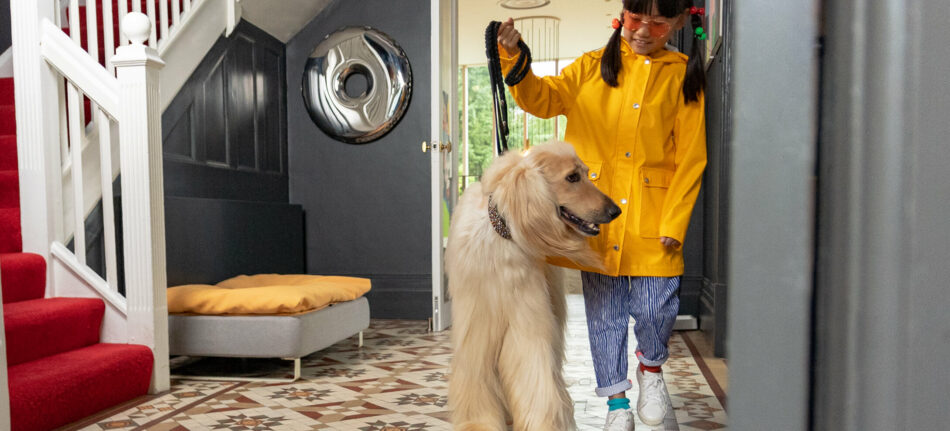
Stick to a seasonal schedule
Winter’s shorter days can disrupt your pet’s usual rhythm, so maintaining a consistent schedule is essential. Feed your pets at the same time each day and stick to regular play and rest periods. For dogs, this might mean planning walks and indoor play sessions around your work schedule to ensure they get enough activity. Sticking to routines provides a sense of security and helps reduce stress during seasonal changes.
Cats, with their naturally structured habits, also benefit from a winter routine. Schedule playtime before meals to simulate their natural hunting instincts, followed by plenty of opportunities for rest. Keep mealtimes consistent and ensure their favourite cozy spots are ready for long naps. By sticking to a predictable schedule, you can help your pets adapt seamlessly to the colder months.
Let winter inspire new traditions
Winter is the perfect season to slow down and spend quality time with your pets. For dogs, start a weekly “cosy night in” tradition with snuggles on the couch and a few extra treats. You could also use this time to create a special grooming ritual, like brushing their coat or trimming their nails, which not only strengthens your bond but keeps them looking and feeling their best.
Cats might prefer a different kind of bonding—think quiet evenings filled with gentle petting or interactive play sessions. Winter is also a great time to introduce new experiences, like a cat-safe blanket fort for them to explore. These seasonal traditions aren’t just about keeping your pets entertained—they’re an opportunity to celebrate the love and companionship that make them such a special part of your family.
Omlet and your pet
At Omlet, we understand that winter brings unique challenges for pets and their owners, which is why we approach our designs with the same curiosity and care that pets bring to the world around them. From cosy dog beds that keep your pup warm to interactive cat scratchers that banish boredom, our products are crafted to help your furry friends thrive during the colder months. By asking the right questions and celebrating the bond you share with your pets, Omlet creates solutions that make winter a season of comfort, joy, and connection.
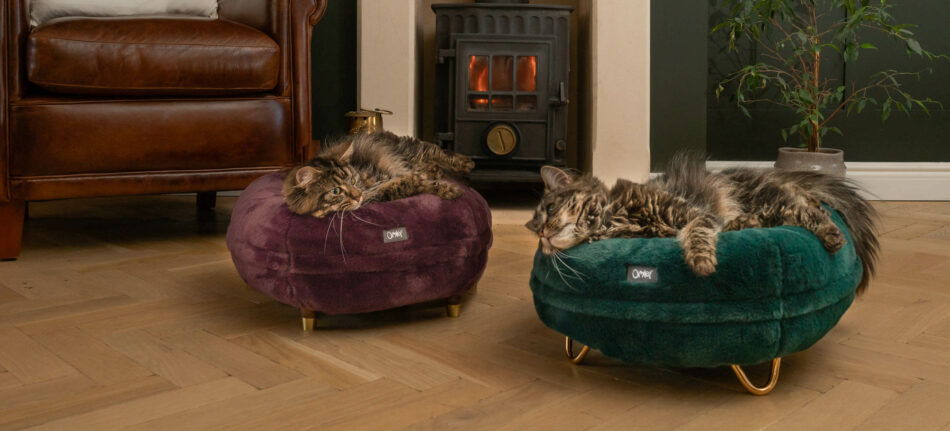

This entry was posted in Dogs on December 29th, 2020 by chloewelch
Holiday Animal Quiz: Can you identify the roles of these animals in these holiday movie favourites?
1.What does the Grinch tie to Max’s head in the movie?

Photo by Woodson’s Mom on Unsplash
A. A twig
B. Holly
C. A bell
D. Mistletoe
2.What does the Grinch steal from a mouse when he is stealing from the Who’s in Whoville?
A. A piece of cheese
B. A cookie
C. A candy cane
D. A crumb
3. Who provides the voice of Rebecca the Hen in the 2017 holiday movie “The Star”?
A. Mariah Carey
B. Keegan Michael Key
C. Aidy Bryant
D. Gina Rodriguez
4. In “A Charlie Brown Christmas”, why is Snoopy decorating his dog house?
A. For Charlie Brown
B. For a holiday contest
C. For Santa
D. For Woodstock
5. In the movie “Annie”, what is the name of her beloved Dog?
A. Goldie
B. Molasses
C. Sandy
D. Butterscotch
6. In the movie “The Holiday” what is the name of Kate Winslet’s Dog?
A. Charlie
B. Chip
C. Jackson
D. Pip
7. What animal says the line “Bye Buddy, I hope you find your dad!” in the movie “Elf”?
A. A whale
B. A seal
C. A narwhal
D. A polar bear
8. What is the name of Snoopy’s bird sidekick in “A Charlie Brown Christmas?”
A. Tweetie
B. Sunny
C. Pebbles
D. Woodstock
9. What is the name of the famous red-nosed reindeer?
A. Rudolph
B. Prancer
C. Dancer
D. Comet
10. How does Rudolph help Santa on Christmas Eve?
A. His nose helps detect rain or snow
B. His nose detects which houses are on the naughty or nice list
C. He flashes his nose to the airplanes to make way for Santa
D. He guides his sleigh
Answers: 1.A, 2. D, 3. A, 4. B, 5. C, 6. A, 7. C, 8. D, 9. A, 10. D
This entry was posted in Pets on December 22nd, 2020 by alicefellows

Dogtor Adem, founder and owner of Dog-Ease, is a dog behaviourist and trainer with over 15 years experience working with dog owners and their canine best friends. In this blog post, Adem talks you through everything you need to know about dog hygiene, and shares his thoughts on the new, easy clean Topology dog bed from Omlet.
With the nights drawing in and the wetter weather becoming more frequent it’s always a struggle to keep the mess out of the house and the dog beds clean and smelling fresh (aux de dog, anyone?) So, when Omlet asked me to review their new Topology dog bed I couldn’t help but get a little excited! The bed features an extremely comfy memory foam mattress that sits raised from the floor on stylish legs (that you can choose to match your style of décor!), has a fully removable and washable cover, and can be ‘topped’ with several styles of zip off top covers that make it easy to keep clean and hygienic.
Firstly, let’s talk about dog hygiene and why it’s important.
Our dogs naturally try to keep themselves clean through the act of licking themselves. To help to keep themselves clean they also try to keep their beds clean and comfortable by ‘clearing the ground’ through digging and circling on their bed areas. In years gone by, when dogs were less domesticated, this was an important act and allowed them to clean and clear their bed area of uncomfortable vegetation, parasites and small creatures that could cause them harm. In fact, our dog’s wild ancestors such as wolves and wild dogs still very much display this type of behaviour. Clearly, in our homes, our dogs do not need to remove vegetation or small creatures from their bed areas before residing in them, however their dog beds if not washed can harbour other harmful organisms – bacteria and fungi. Studies have found bacteria and fungi such as MRSA, Salmonella, ringworm and listeria, as well as fecal matter, on our beloved dogs’ beds. Pollen can also be brought in, as well as general dirt and grime, which can aggravate allergies and skin conditions that both we and our dogs may have. It is also important to remember that bacteria and infectious diseases can be passed from animals to humans (these are known as zoonotic diseases). As a result, it is important for both our dog’s health and our own health that we regularly clean our dog’s body and bed area so that they are less likely to be carrying any harmful organisms that could make them or us unwell.
So, how can we keep our dog’s clean?
The key to keeping your dog clean is to regularly groom your dog. Whether you choose to do this yourself or perhaps book a professional to carry this out (or choose to combine both approaches!) It is a good idea to ensure that your dog is confident and finds being groomed and handled in this way a positive experience. This will not only make it easier to fully groom and fully clean your dog, it will also help to ensure that your dog enjoys the experience and does not become stressed or fearful. If your dog has never been groomed before, or perhaps already shows an aversion to be groomed, take your training for this slowly. Start with short sessions that simply introduce your dog to the type of items they might encounter or need to be touched with when being groomed. Think brushes, nail clippers, towels, and so on. It is a good idea to just allow your dog to observe these to begin with whilst you praise positive and confident behaviour around these objects with a tasty treat. Once your dog is confident around the chosen grooming objects you can then progress on to bringing them closer and perhaps interacting with and touching your dog with the grooming tools. Again, don’t forget to reward positive and confident behaviour as you do so. Continue with this approach slowly, building up your dog’s understanding and confidence, until you are able to fully handle and groom your dog as is needed. If your chosen method of cleaning your dog is a grooming parlour, you might also want to visit this location a few times prior to leaving your dog there. Remember to take your introduction of these items and to this new experience at your dog’s pace and don’t be afraid to go back a step if needed.

What actions can we teach to help make cleaning our dog easier?
In order to help you to groom and handle your dog with ease there are a few key actions I like to help owners to teach their dogs and would recommend that you structure into your training schedule.
The first is ‘stand’. Although at first glance this might seem like a bit of a boring ‘action’ (they’re just standing still, right?!), this is actually a very useful command. If your dog understands this command they will be able to stand still whilst you perhaps wipe their paws and legs when coming in from a wet or muddy walk, when needing to check for grass seeds or sticky fauna that might have attached itself to their coat whilst walking, or when brushing their body – particularly their chest and stomach area. It can also be useful to you or a groomer when washing your dog, allowing you or your groomer to clean all parts of their body with ease.
The second command is ‘flat’. This is where the dog lays flat on their side. Again, this can help with general grooming of their coat and, in particular, being able to easily clean ears and eyes as well as enabling easy access to clean your dog’s paws and clip their nails.
The third command I would recommend is ‘twist’. This is where you teach a twist or spin command and I like to use this whilst my dogs are standing on the front or back door mat after a walk so that effectively they are wiping their own feet! This action can also be a fun one for children to practice alongside their parents to help keep the family dog clean as well as be an entertaining party trick!
How can we keep our dog’s bed clean?
If we are keeping our dog’s nice and clean it makes sense to also keep their beds clean – if you think about it, you wouldn’t shower to then get into a bed that hadn’t been washed for months! The most obvious way to keep our dog’s bed clean is to wash their bed. This is easier said than done with many beds on the market being too large for the average washing machine or not having removal covers that can be washed. At minimum, loose debris needs to be regularly removed from the bed and the bed should then be disinfected with a suitable animal friendly cleaner. Ventilation is also key to ensuring beds stay clean and hygienic as airflow ensures that any moist areas are able to dry quicker and that bacteria is limited in its ability to grow (dark, warm and moist areas encourage bacteria growth). Hanging your dog’s bed out in the sun to dry can also assist with elimination of any remaining bacteria after washing and of course after cleaning your dog’s bed it is also important to ensure it is fully dry before allowing them to use it again.

What if my dog doesn’t seem to like to sleep on their own bed?
In order to minimise the built up of dirt, fur and bacteria in places in your home that you may not want them, it’s important that we make our dog’s designated bed area as inviting as possible so that this is the area they choose to reside in. Think about the type of bed your dog prefers. Some breeds like to stretch out whilst others like to curl up. Some prefer a comfortable flat surface, whilst others prefer to cuddle into sides that make them feel cosy or more secure. The more inviting and comfortable your dog’s bed is, the more likely your dog is going to want to reside and sleep on it. It is good practice to observe how your dog likes to reside so that you can buy a bed for their individual preference. This is the first step to encouraging your dog to reside on their designated bed area.
If you have ensured that your dog’s bed is as inviting as possible and your dog still does not seem to want to sleep on it, think about the location of your dog’s bed. Is it in a draft free area? Is it away from direct sunlight that could make them hot or is perhaps uncomfortable on their eyes? If so, the next step is to practice making their bed area a safe and fun place to reside. You can teach the action ‘go to bed’, offering a tasty reward for their compliance. You can also offer food items such as chews and food dispensing toys on their bed, encouraging them to stay in this area and making it fun to do so.
It is also important to ensure that your dog is ready to settle and lay on their bed area by ensuring they have had enough mental and physical stimulation across the day to tire them and help them to then relax. This last point can also help with addressing the behaviour issue ‘separation anxiety’, which may be another reason why your dog might prefer to perhaps sit physically close to you rather than on their bed. If you suspect your dog has separation anxiety it is advisable to seek help from a behaviourist to address this issue so that your dog is able to lead a confident and stress-free life.
What does this mean we should ideally be looking for in a dog bed?
Given the above, my recommended ‘wish list’ for a bed would be that
- It is easy to clean with removable covers
- It is easy to clean around and under the bed, and ideally raised off of the floor to allow ventilation
- It suits your dog’s individual preferences i.e. is big enough to lay flat on, or perhaps has comfy bolster sides if your dog likes to snuggle into these.
The Omlet Topology ticks all these boxes, plus looks super stylish and can be styled to fit a range of interiors. The zip off top also makes extremely light work of regularly cleaning the bed, and if you purchase more than one topper your dog never needs to be without a clean place to reside! After trying out the Topology bed for a few weeks now, I’m about to purchase another, my dogs love this bed and so do I!
Dogtor™ Adem
Dog Behaviourist and Trainer
Owner of Dog-ease
www.dog-ease.co.uk
This entry was posted in Dogs on December 16th, 2020 by chloewelch
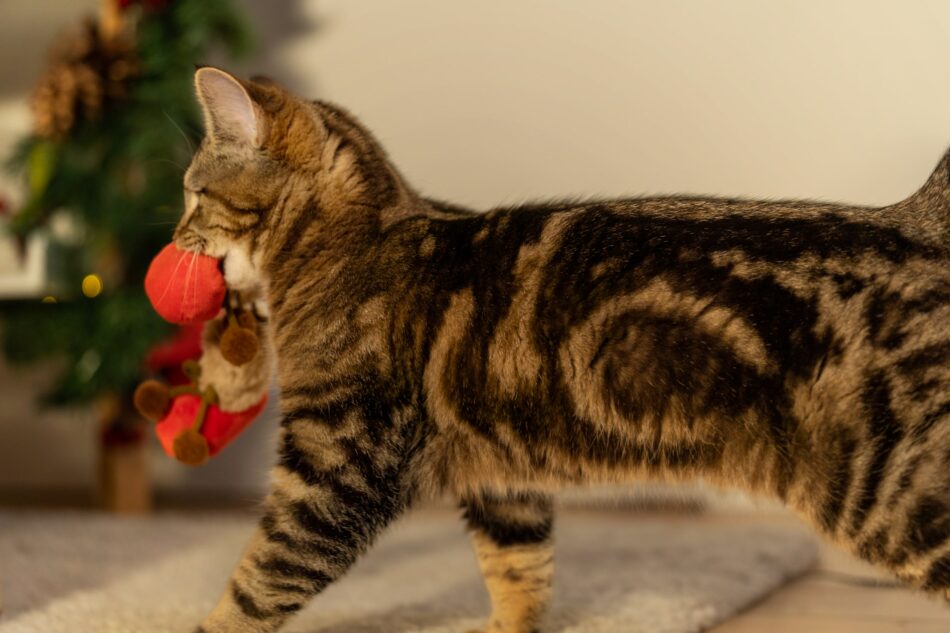
Christmastime offers a great opportunity to spend quality time with family and friends – and that includes pets. But, it’s also important to remember that what we enjoy about the festive season isn’t the same for our furry or feathered friends. With a bit of care and consideration, though, you can make sure this time of year is a fun time for your pets too. These ten top tips for helping your pets to have an amazing Christmas break will set you on the right track.
1. Turn down the volume
Christmas and New Year are noisy, with people, music and games all adding to the decibels. For cats and dogs, it may simply be a case of looking for a quiet spot, although many dogs will even be perfectly happy at the centre of the party. Caged pets such as budgies, finches, parrots and small mammals, though don’t find it so easy to escape the noise.
If possible, cages should be placed in a quieter part of the house if there’s a party taking place in the main room. The Omlet Qute Hamster Cage is the perfect home for one Syrian hamster or two gerbils, with optional wheels to make moving their space from one room to another easy.
2. Forgo the fireworks
The biggest bang comes from fireworks. While some pets will simply head for a safe corner, others are absolutely terrified. If you’re the owner of a nervous pet, speak to your vet as they may be able to prescribe medication to help them relax. For cats and dogs, you can also try pheromone diffusers a few weeks before the fireworks begin. Take a read of our pets’ guide to surviving fireworks blog for more tips on pet safety during this time.
3. Go easy on the treats
There’s lots of food around at Christmas. Your dog will be more than happy to eat leftovers and treats all day, given the chance, but this doesn’t make it a good idea. As far as your dog is concerned, it’s best to treat Christmas and New Year like any other day, perhaps with a simple treat such as a few slices of plain turkey with the evening meal.
The same applies to other pets, and you’ll also need to make sure that everyone knows the rules. A well-meaning guest might try to feed pretzels and salted peanuts to the hamsters and gerbils, or pieces of Christmas cake to the pet birds. These human snacks will bring no benefit to your pet, and some items are even highly toxic. You can find our series of pet-safe festive foods here:
Christmas foods to avoid giving kitty
Christmas treats for rabbits and guinea pigs
Christmas food do’s and don’ts for dogs
4. Hang on to some routine
During this season, it’s easy to lose your routine. You’ll probably be in bed later than usual, enjoying a few too many lie-ins, and preoccupied with children and guests. With everything else going on, there’s a chance that daily tasks such as refilling your pets’ food bowls, closing the hen house door or even skipping the dog walk can fall off the radar.
Most pets will already be thrown by a change of environment from all the Christmas decor, so it’s important to minimise stress as much as possible and keeping their routine as familiar as possible will help.
5. Visitor pep talks
Some dogs love crowds and attention from new people, but even the most sociable of canines need time to chill. Chances are, you’ll have plenty of visitors over Christmas and some pets won’t appreciate all the extra fuss.
Speak to guests beforehand about your pet’s temperament and what the boundaries are. If there are young visitors, be wary of potential cage-rattling and chasing pets. You also need to remember that birds like to have lights out in the evening, so make sure your late party doesn’t turn into an all-nighter for the budgies, finches and parrots, too. If the room isn’t too noisy, a bird cage cover might suffice; otherwise, relocating the pet cage will be the best option.
6. Keep the pets at home
If you’re travelling away for Christmas, arrange for someone to look after your pets. Consider a cat sitter or chicken sitter if you’re planning on an extended trip away. If this isn’t possible, look into local catteries and kennels.
You can consider taking your dog with you if you’re heading away for Christmas, though. Fortunately, there are many dog-friendly holiday spots available, meaning Fido doesn’t have to miss out on the fun.
7. Winter weather safety
If you’re planning on keeping your pets in another room for the Christmas party, or if they are kept in the backyard all year round, you need to take special measures to ensure they remain warm.
Cats and dogs will benefit from a super cosy pet throw such as the Faux Sheepskin Dog Blanket and Super Soft Cat Blanket from Omlet. Opt to place them on your bed or theirs for optimum comfort and warmth.
For smaller pets kept outside, take a read of our Will my rabbit be okay in winter? guide and our How to prepare guinea pigs for winter blogs. Chickens might be kept outside whatever the season and are hardy pets, but extra precautions should be taken over winter. A well-insulated chicken coop such as the Eglu Cube will go a long way in keeping your flock toasty but they’ll also appreciate an extra layer of protection on their coop from temperature protection jackets.
8. Clean up time
The Christmas season tends to involve lots of pet hazards – wrapping paper, bows, ribbons, tinsel, and bits of plastic to name just a few. To avoid these items ending up in your pet’s mouth or wrapped around their legs, be sure to get everything tidied away once the presents have been opened.
9. Christmas tree watch
A Christmas tree can easily be bashed by wagging dog tails and adventurous cats attempting to climb. For one, it’s a good idea not to have heavy decorations high up on the Christmas tree, as these could easily fall and break, and nothing fragile (or valuable) should be kept within reach of an excited tail.
If your cat’s fascination with the tree doesn’t wane, get them a Christmas tree of their own with the Switch Cat Scratcher. Put simply, it’s the coolest cat scratcher since time began. With the help of tech and tireless testing from our in-house cats, we’ve designed a cat scratching post that your Christmas tree definitely won’t be able to compete with.
With over 1,200 irresistible light modes, the Switch is attractive to our eyes as they are fascinating to feline ones. Plus, with a bamboo base that lasts indefinitely and 100% biodegradable sisal sleeves, your cat’s Christmas wish will be granted all year long.
10. New pet? No worries
You’re probably familiar with the saying that a dog is for life, not just for Christmas, but the same applies to any pet. If you’ve carefully considered that pet ownership is right for you and you have the resources to do so, bringing them in amongst the festive chaos isn’t the best time to put your plan into action But, if you have had a recent animal addition to the family in the past few months, navigating their first Christmas is something you need to account for.
First of all, make sure that new cats and dogs have been introduced to any other pets that could be joining you over the season to avoid potential confrontations. Also, ensure that your home is still pet-proof with any decorations you’ve added to your usual setup. This will likely be their first time experiencing a Christmas and New Year, so pay special attention to how they’re reacting, making sure to remove them from situations that are making them uncomfortable.
Omlet and your pet’s Christmas
At Omlet, we know that pet ownership over Christmas isn’t always as glamorous as your festive family portrait might portray. Christmas tree chaos, gatherings and winter weather might be obstacles but with Omlet’s range of innovative pet products such as our Switch Cat Scratcher, easy clean Eglu Cube Chicken Coop and cosy Faux Sheepskin Dog Blankets, we can help make Christmas as smooth sailing as they can be.
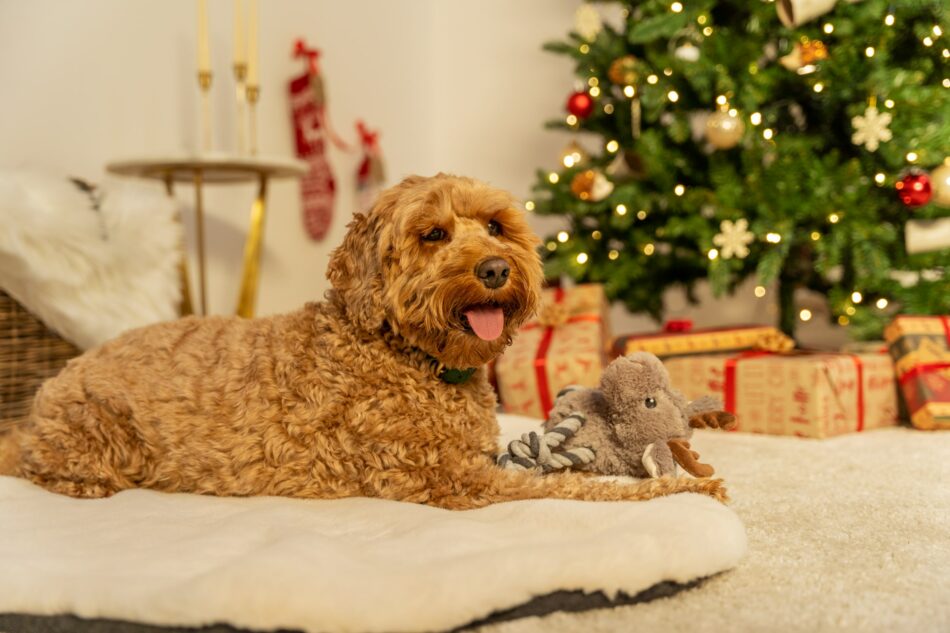
This entry was posted in Christmas on December 12th, 2020 by chloewelch
Still looking for the perfect gift for a pet-lover in your life? You’ve come to the right place! Take a look at our last minute gift ideas below…
For chicken keepers

Who doesn’t love the delicious, fresh scent of peppermint? Now chickens and their owners can enjoy that sweet scent in their coop’s nest box with our Candy Cane Coop-pourri. This limited edition festive scent will be a hit with hens and humans alike this Christmas and makes the perfect stocking filler.
Our Christmas Jumper Chicken Jacket is the must have accessory this festive season. The classic jumper, complete with a reflective pattern, is made from breathable, showerproof fabric and offers excellent comfort and protection in cold weather, as well as protection from dirt. Do you know a chicken keeper who would love this for their star hen?
For dog and cat parents
Fresh off the sleigh, our new Luxury Super Soft Christmas Blankets in a suitably festive poinsettia red are the perfect gift for dogs and cats who love to snuggle up, and they’re reindeer approved (probably). Choose from three sizes to suit your friend’s four legged companion.
The Omlet Christmas Market is full of novelty treats for dogs and cats! For the cheese lovers, why not get their dog their own Cheeseboard Platter to enjoy? Or there’s a cute Christmas Paw Cookie for dogs made from peanuts, milk and oats, with no added sugar, for those who like a sweeter treat. The Rubber Belly Santa Dog Toy will keep pups entertained over the festive season, while the Joules Olive Bee Water Resistant Coat is a great choice for stylish, pampered pooches.
 For cat lovers there’s delicious Turkey Strips, a Christmas Koala Cat Toy filled with catnip, or a Metallic Feather Teaser Cat Toy complete with a cute gingerbread man for cats who love to pounce and leap for hours!
For cat lovers there’s delicious Turkey Strips, a Christmas Koala Cat Toy filled with catnip, or a Metallic Feather Teaser Cat Toy complete with a cute gingerbread man for cats who love to pounce and leap for hours!
For small animal owners
The Zippi Shelters and Play Tunnels make a thoughtful gift for rabbit or guinea pig owners who love to add new and exciting features to their pets’ run. The Caddi Treat Holder is also a great way for owners to feed their pets vegetables in winter, without food getting mucky on the run floor.
The Naturals Festive Fruit Tree is a tasty, festive gift for all small animals, while hamsters and gerbils will love hiding in the Santa Sack Den & Cave.

This entry was posted in Christmas on December 9th, 2020 by chloewelch
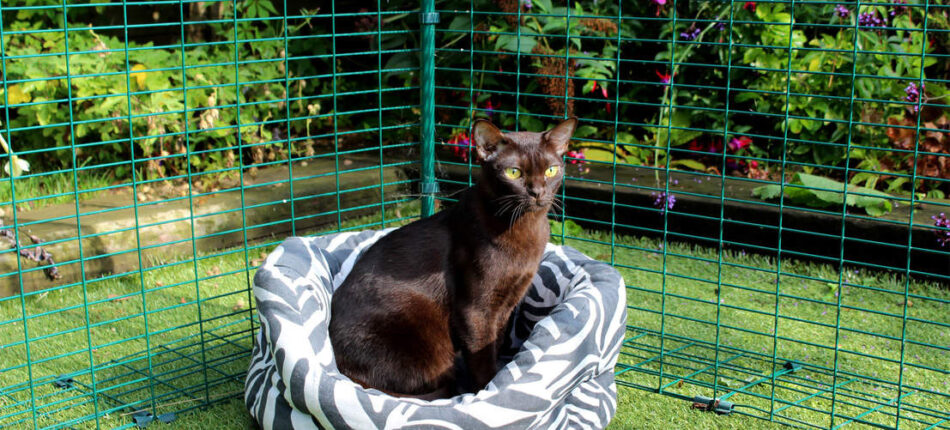
In Britain, the fact that black cats are considered unlucky is a complete reversal of the original belief that black cats brought good luck. It is white cats that were originally considered unlucky. So, what caused this drastic change of fortune that now leaves us with the question of why are black cats unlucky?
There is an explanation behind this is transatlantic exchange. In America, which in its early days was obsessed with witches and witchcraft, black cats i.e. the classic pet of the witch, were demonised. This superstition was then imported along with all the other traditions of Halloween. What Halloween goody bag is complete without something related to pumpkins, bats and black cats of course?
Are black cats a sign of bad luck?
The American blacklisting of black cats is linked to the days when British settlers were founding colonies in New England. These founding fathers were Christian fundamentalists, hounding out anything they perceived as witchcraft. Witches and their pet cats were viewed with fear and hatred, and a black cat was thought to be particularly demonic. They are featured regularly in witch trials of the period.
This classic US symbol of bad luck began to overturn the black-cat-good-white-cat-bad superstitions of pre-20th century Britain after the appearance of the 1934 movie The Black Cat. The film was based on a short story by American horror writer Edgar Allen Poe, which was first published in 1843. The commercialisation of Halloween in the last few decades has set in stone these superstitions of the black cat as a scary beast.
Are black cats lucky or unlucky?
The reason why black cats hadn’t been demonised in Britain was that witches and their cats had always been there, originally as part of everyday life. And there was nothing sinister about keeping a cat – they were the only means of controlling the mouse and rat population. The so-called witches were the herbalists and healers of the villages, the Middle Ages version of the GP.
Black cats used to be thought lucky on board ships, not only keeping the rodent population under control, but helping to keep storms away too. Fishermen’s wives sometimes kept black cats at home to ensure their husbands were safe at sea. However, if the cat ran away, or if a random black cat hopped on board and then off again, it meant the ship was in danger of sinking.
In Scotland, the arrival of a black cat in a house was said to be a sign of good fortune. In general, a black cat taking up temporary residence on a porch was said to be a good omen. This is an echo of superstitious ages gone by, when felines (and not just black cats) symbolised domestic happiness. In Ancient Egypt, for example, the cat-shaped goddess Bastet was a symbol of domestic bliss and good fortune.
Gladstone – the black cat of Whitehall
The tradition of black cats as bringers of good luck still survives at the heart of the British government. Whitehall has adopted several cats from Battersea Dogs & Cats Home over the years, for the traditional role of mouse hunter. Many of them have been black cats, including the current holder of the post, Gladstone, who began his official government work in 2016.
Gladstone the black cat is a social media star, not surprisingly. His popular Instagram page makes him one of the most famous black cats around today.
What is the superstition about a black cat crossing your path?
In some parts of the world, including Britain a few centuries ago, the direction of travel of a black cat crossing the road was important. If the cat crosses your path left to right, it means good luck. If it goes the other way, it means bad luck. Similarly, if the cat walks towards you, it brings good luck, but if it runs away from you, it takes the good luck with it. For this reason, chasing a black cat from your property is said to bring misfortune.
The ultimate symbol of a black cat running away is when it dies. In the 1640s, King Charles I was reported to have said that he owed his good fortune to his pet black cat, and that he dreaded the day its nine lives were used up. Shortly after the cat’s death, Charles – having been on the losing side in the English Civil War – was arrested and eventually beheaded.
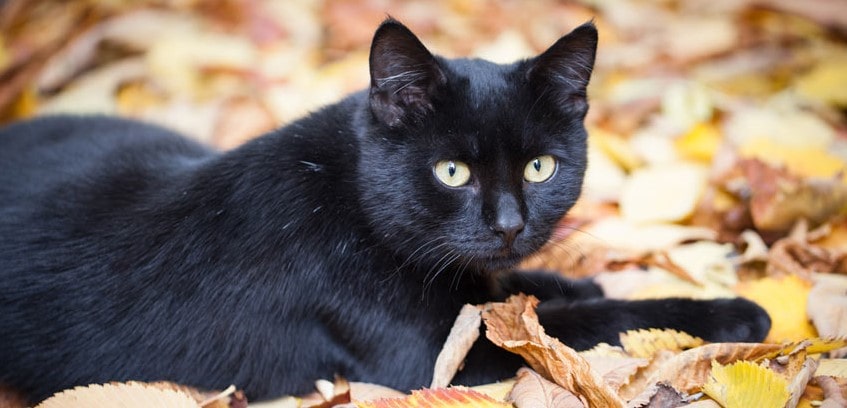
Where do black cats originate from?
In folklore, the witches’ black cat has very deep roots indeed. In Greek mythology, Hecate, the goddess of witchcraft, had a black cat that had originally been Galinthias, a servant of Hera (wife of the god Zeus). She had turned him into a black cat as punishment for trying to prevent the birth of Hercules. Shakespeare’s witchcraft-coloured play Macbeth features Hecate (although her black cat is not mentioned).
Putting all superstition about cats aside, a black cat is simply a cat with the maximum amount of melanin, which turns the fur black. Pure black cats are rare in cross-breed cats, and it is thought that only 22 of the recognised cat breeds can have completely black varieties. If you’d like to find out more about different types of cats, take a read of the Omlet Cat Guide.
The superstitions about black cats may all sound like simple good fun, but there are definitely downsides. Stray cats and kittens with black fur are harder to relocate, and there are stories of black cats being abused by some trouble makers during Halloween. So, even though we may dismiss the superstition about unlucky black cats as harmless fun, it can still cause very real problems.
The truth of the matter is that black cats, along with all other cats, are wonderful and bring nothing but good luck. The estimated 200 million cat owners worldwide will certainly vouch for that!
Do you believe black cats are unlucky? Superstitious or not, one thing that can’t be denied is how much joy cats bring to the lives of their owners! Treat your purry pal to Omlet’s wide range of Cat Products including the innovative Freestyle Cat Tree to give your feline friend the fun they deserve!
This entry was posted in Cats on December 5th, 2020 by chloewelch
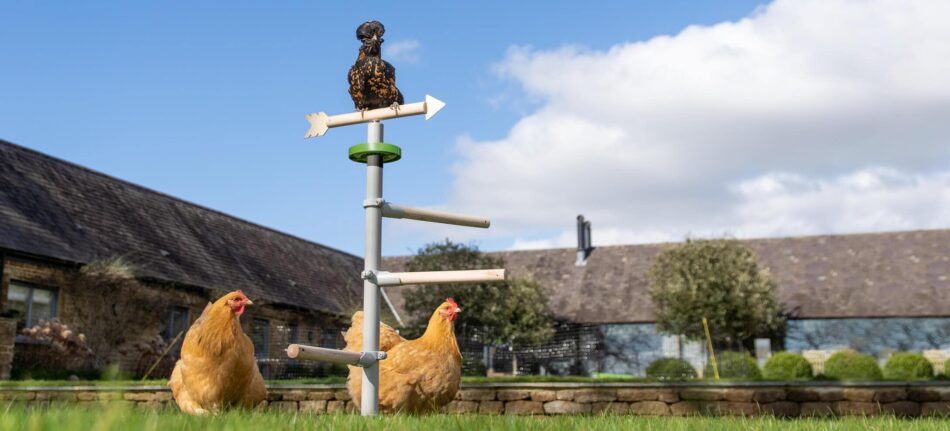
Most chicken keepers will fall into the eventually of “chicken math”. First, it was three, then four and now you’re thinking an eighth hen wouldn’t hurt…right? The idea of having flockmate best friends sounds great, but being the same species isn’t always enough for chickens to live in harmony. Certain chickens get along better than others, but which breeds make for besties?
Normal chicken behaviour
All different breeds of chicken have been developed from the same ancestor, the Asian Jungle Fowl, and so fortunately, most chickens get along, regardless of the variety. However, there are some exceptions to this general rule.
Any new hen introduced to a flock will need to be separated from the other birds, but still be able to see them through a fence, for a week or so until all the birds get used to each other. Once introduced, they will find their natural place in the chicken pecking order, and that may involve a little bullying and squabbling in the early days. This is all very natural and has nothing to do with feuds between specific breeds.
Occasionally, one hen will fall out with another for no obvious reason, and the weaker chicken will sometimes be pecked and harassed by the more aggressive bird. If this situation continues for more than three days after introducing the new chicken, the two combatants may need to be separated.
What breeds of chickens are aggressive?
Some chicken varieties are more confident and assertive than others, but this does not make them aggressive. Aggression is usually the result of environment – poor living conditions – or visual stimulus. The chicken bullying only usually persists beyond the first few days if the new hen has unusual plumage on its head. The fancy crown of feathers on the Araucana, Houdan, Poland, Silkie and Sultan breeds, for example, is like a red rag to a bull for some hens.
The reasons for this aggression are purely instinctive. Chickens respond to the size of their fellow birds’ combs, and there is evidence that larger-combed chickens tend to dominate the pecking order and will challenge any large-combed newcomer to assert and retain her dominance. No one is entirely sure how the visual stimulus works with feather-crowned breeds. A chicken with feathers on its head is judged by the other hens to be one of two things – either a bird with a very large comb, and therefore a threat, or one with no comb at all, which makes it fair game for some bullying. Whichever way a hen looks at it, the feather-headed newcomer is a direct challenge to the dominant birds.
Birds with fancy head feathers are additionally vulnerable because the plumage flops in front of their eyes, impairing their vision, and so they may not spot an oncoming attack. This can result in pecks and injuries.
Other causes of chicken bullying
Other unusual feathering will occasionally inspire bullying amongst chickens, such as the feathered ‘trousers’ of the Faverolles. This is not generally a problem, though, and this breed should get along well with your other hens.
Sometimes, new chickens with no unusual feathers or peculiar combs may be picked on if they are a different breed from all the other hens in the flock. The bullying appears to take place simply because the new chicken looks different to the others. This is an unusual issue, though, and clearly, the problem disappears if your existing hens are a mixed breed flock.
Do chickens bond with each other?
In general, mixing breeds actually assists with the pecking order and the general bonding, as different varieties have different temperaments. There is more likely to be squabbling in a run that has chickens of a single breed – they may all be assertive and dominant, or they may all be shrinking violets, depending on the breed, but they still need to establish a pecking order.
The body size of the hen does not affect how it is treated. A dainty bantam can rub along fine with a hulking Sussex, and a cockerel will be respectful of all his hens, regardless of their breed, and in the vast majority of cases the birds will all get on well together.
There are other practical considerations when keeping a mixed flock. Some chickens thrive in cold weather, while others are not as robust. Age may be an issue too, if you want to minimize the number of changes in your chicken flock. This isn’t to say chickens of different ages can’t get along but older chickens are more likely to bully other flock members. If possible, wait until your younger birds are close in size before moving them in.
What chicken breeds get along best?
Some breeds are naturally friendly, and these varieties are far less likely to start pecking and bullying each other. Super-chilled backyard chickens include Australorps, Cochins, Easter Eggers, Rhode Island Reds, Silkies, Sussex and Wyandottes.
Omlet and your flock
Whether you’ve got a flock of ten or two, Omlet has the products to support the needs of your chickens. Keep your hens mentally and physically stimulated to help them live in harmony with our range of chicken toys and accessories to add to your chicken coop and chicken run.


This entry was posted in Chickens on December 4th, 2020 by chloewelch

















